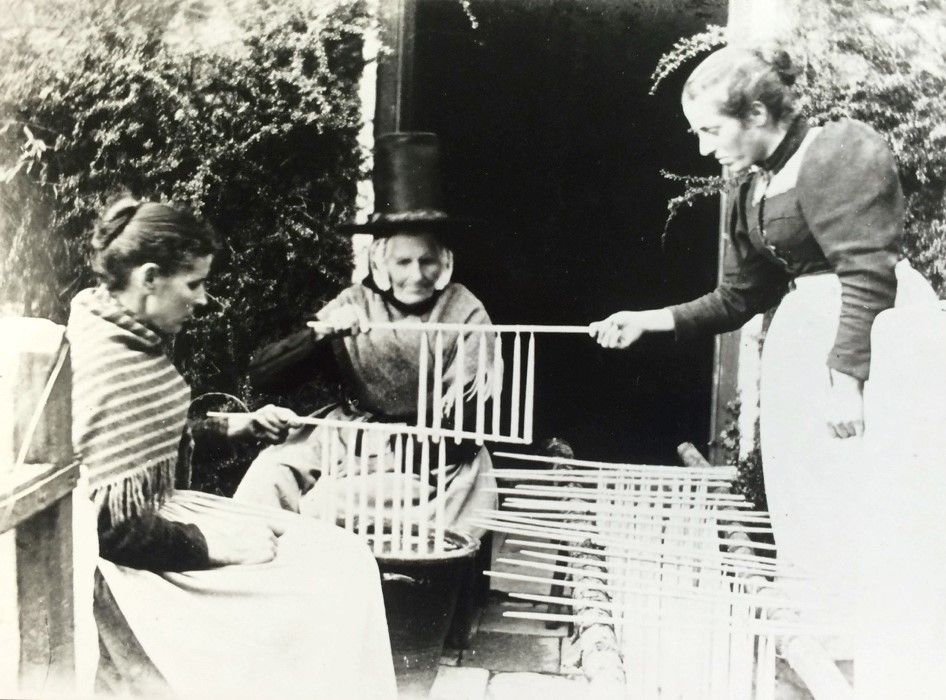Artist in Residency: Building a Play Area. Researching the Archive: Play, Hauntings and Women of the Land by Fern Thomas
, 22 Ebrill 2016
Fern Thomas is one of the supporting artists currently working in St Fagans with Nils Norman. She has been undertaking research which feeds into the design of the play area. Fern is an artist based in Swansea and is interested in the connections between history, folk magic and ecological futures.
Sometimes a building or a place seems to hold an echo or a trace from its past. It is not something that is tangible, but rather a feeling that can be sensed or imagined into. Many of the buildings at St Fagans possess this quality or phenomena. Alongside the age-appropriate furniture, it is perhaps the darkness and firelight of the stone cottages or farmhouses that evoke the past, showing us how the shadows fell and danced across the stone walls, how the glow of the fire would have lit up the faces of those who lived there.
I have had a similar experience to this whilst researching the archives in these recent months. As artist in residence I have had the privilege of exploring St Fagans archives and collections whilst I search for objects, patterns, customs, stories and moments from our Welsh history that could inform the design of the new play area at St Fagans by artist Nils Norman. The play area is intended to reflect the buildings and wider collections of St Fagans, offering the opportunity during this research stage to explore all aspects of the collections; from agriculture to needlework, as well as the collections associated with play.
The criteria of the brief has created an interesting framework in which I view and experience the archive, where every item or photograph I encounter invites me to question if this object from the past could be reinterpreted by Nils Norman as an object of play for children to engage with at the museum. This process has been heightened and informed by observing my one year old as he begins to interact with space, scale, and the alternative use of everyday objects!
In my research I have found myself most drawn to the photographic collections where, alongside documentation of objects on display or housed in the stores, are photographs of people captured in their everyday lives; be it collecting hay, hanging out the washing, attending agricultural shows, ‘beating the bounds’, playing at amateur dramatics, or as by-standers at a funeral or historical event. Whether posed or captured in the moment, all of these images offer a window into life unfolding.

As I continue to look through the filing cabinets image by image I discover that there are these hauntings. Much like the echo from the buildings, some of the images hold an evocative quality, a presence that can be felt that transcends the elapsed time between then and now. Young women in the field stare out at me, a crowd gathers at a mill after a fire. Then there are the incidental moments within the photographs, details that open up a set of questions. Who are those boys peeping though the back of the tent at the vegetable show? Where are the (presumed) mother and child in the corner of the image walking to?




If you are a daydreamer it is easy to wander off. Narratives unfold and questions are sparked. What are they doing there? Is that a relative of mine? Could it be an ancestor? Surely we have the same nose. I find myself becoming aware that I am looking for my own past as I learn more about the nations collective history.

Women of the archives have become a particular fascination over the past few weeks. I have encountered them in their arduous domestic roles as butter makers, bread bakers and cow milkers. There are also photographs of women in the landscape, carrying firewood or collecting water from a well, inviting me to consider the connection to the land that was inherent in everyday life that I perhaps do not experience.

There is a section in the photographic archives dedicated to ‘Dyn hysbys’ (wise man), this would have been a local man offering remedies, healing and solutions to everyday problems. I haven’t (so far) come across a similar category for women which would perhaps be ‘gwrach’ (witch) or wise woman. As I search I begin to imagine what is not present in the archives - the undocumented actions, beliefs and role of women who were of the land; who knew how to make a healing poultice for a burn or bite (though there are some excellent hand written remedies from women across Wales collected by researcher S. Minwel Tibbott during the 1960’s), who worked with the seasons or conversed with the bees. Witches perhaps, but not witches with pointy hats (though they are present too!) or ‘hags’, but women who had a relationship with nature, and who could offer us an interesting view on our modern day disconnection from the land.

Often in the archives women are cited as ‘the wife of so and so’ or ‘gwraig’ and in my very small knowledge of Welsh language I try to make the connection between the two words ‘gwraig’ and ‘gwrach’. I discover (for myself at least) that, according to the Geiriadur Prifysgol Cymru, in the middle ages the two words had a blurred meaning, and that in some instances ‘gwrach’ could simply mean ‘old woman, mother’ which for me suggests every woman was a sorceress, healer or worker of magic!
As I continue then to look upon every image within the filing cabinets I find myself asking; ‘where are the witches of Wales?’ and could there be value now in remembering the shared meaning in the words ‘gwraig’ and ‘gwrach’?
